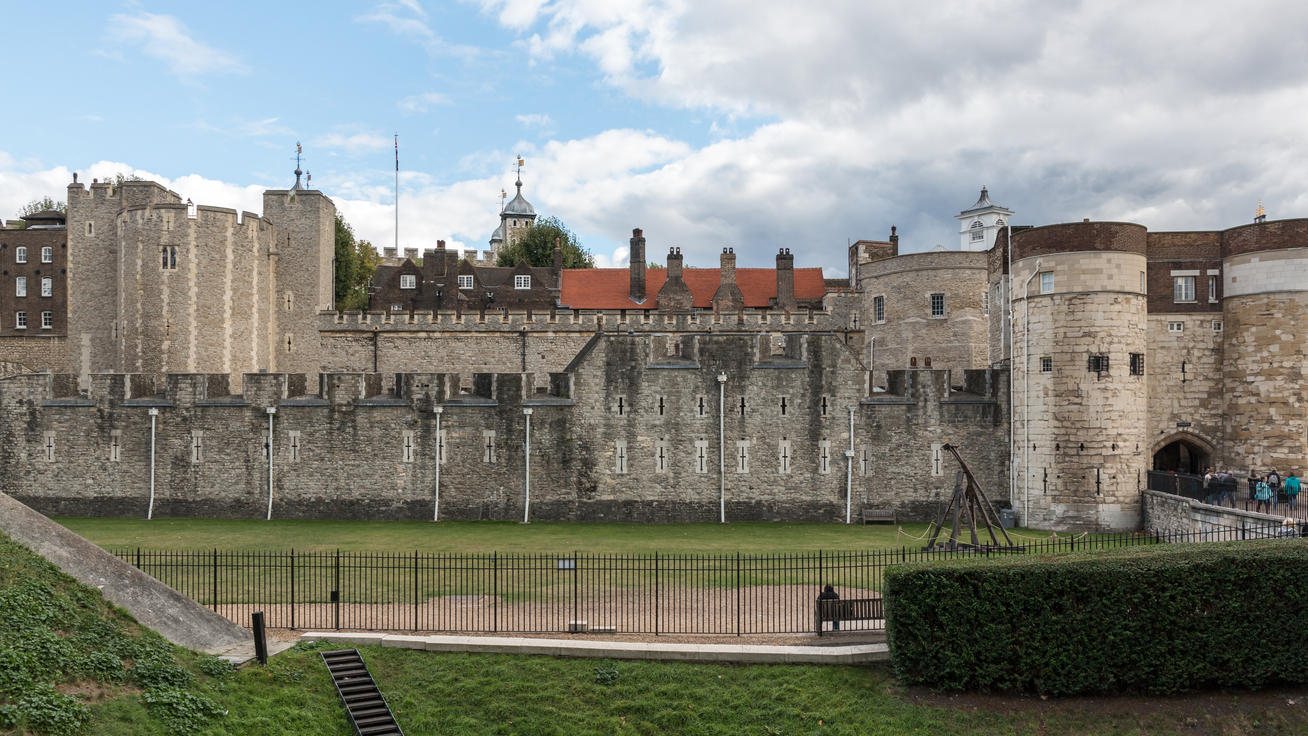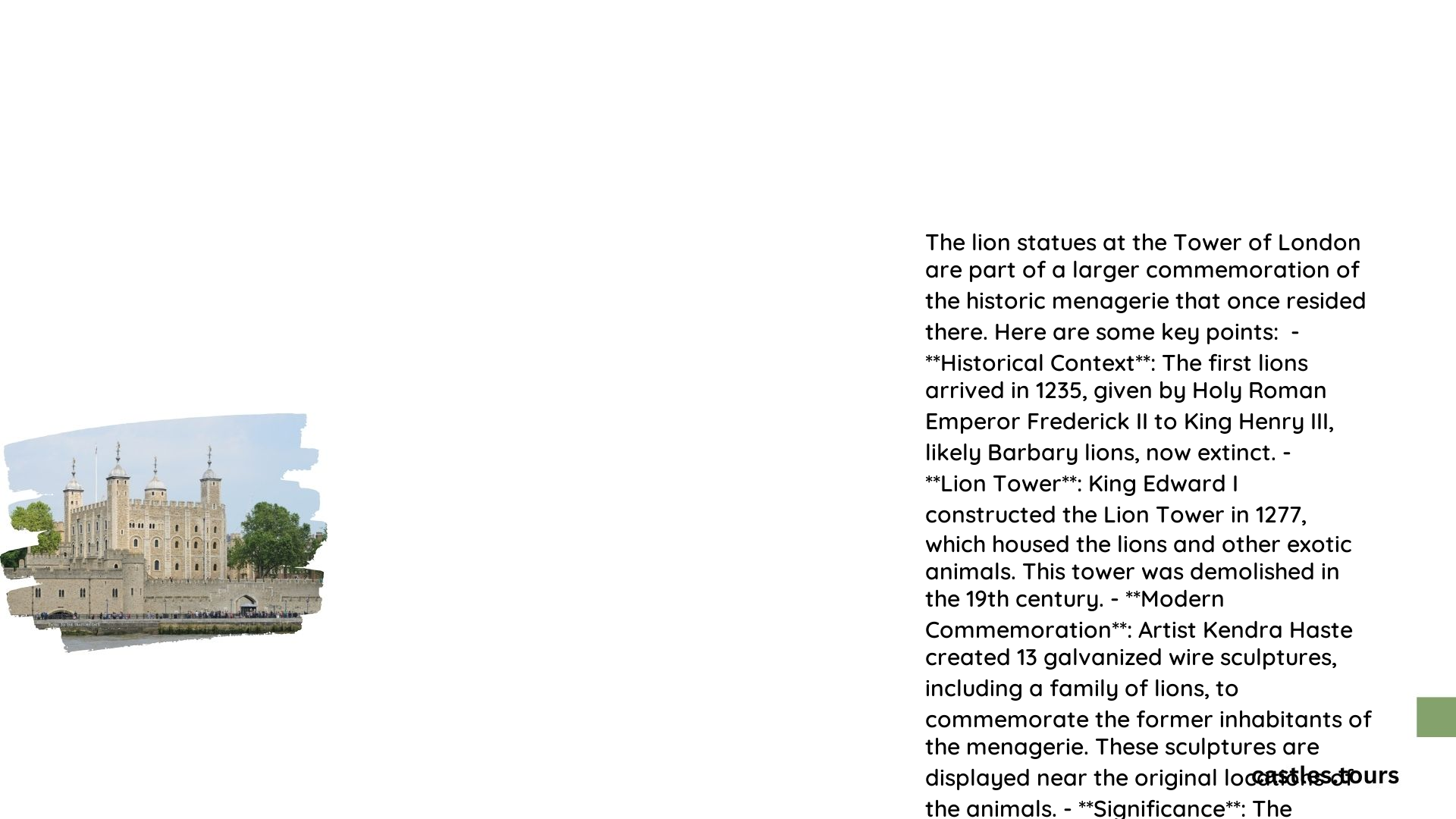The Tower of London lion statue is a captivating wire sculpture that pays homage to the historic royal menagerie once housed within the fortress. Created by artist Kendra Haste, these lifelike galvanized wire sculptures stand as a testament to the exotic animals that once roamed the Tower grounds. The lion statues, along with other animal sculptures, offer visitors a glimpse into the rich history of the Tower’s menagerie, which began in the 13th century and lasted for over 600 years.
What is the Historical Significance of the Tower of London Lion Statue?

The Tower of London lion statue holds immense historical significance as it represents the royal menagerie that was once a prominent feature of the Tower complex. The menagerie’s history dates back to 1235 when King Henry III received three leopards (or lions) as a wedding gift from Holy Roman Emperor Frederick II. This marked the beginning of a long-standing tradition of keeping exotic animals at the Tower.
The royal menagerie served multiple purposes:
- Symbol of power and prestige
- Diplomatic gifts from foreign rulers
- Source of entertainment for the royal court
- Educational resource for scholars and naturalists
Over the centuries, the menagerie housed various animals, including:
- Lions
- Tigers
- Leopards
- Bears
- Elephants
- Monkeys
- Birds of prey
The presence of these exotic creatures at the Tower of London demonstrated the far-reaching influence of the British monarchy and its connections with distant lands.
Where Exactly are the Lion Statues Located in the Tower of London?

The lion statues, along with other animal sculptures, are strategically placed throughout the Tower of London complex. They can be found in areas that correspond to the historical locations where the live animals were once kept. Some key locations include:
- Near the site of the former Lion Tower
- Along the periphery walkway
- In proximity to other former animal enclosures
These carefully chosen locations help visitors visualize the layout of the original menagerie and understand how the animals were displayed and cared for within the Tower grounds.
What are the Unique Design Features of the Tower of London Lion Statue?
The Tower of London lion statue boasts several unique design features that make it a remarkable work of art:
-
Material: Crafted from galvanized wire, the sculpture combines durability with artistic expression.
-
Lifelike Appearance: Kendra Haste’s meticulous attention to detail results in a highly realistic representation of a lion, capturing its muscular form, mane, and facial features.
-
Scale: The sculpture is designed to be proportional to a real lion, enhancing its visual impact and authenticity.
-
Artistic Technique: Haste’s skillful manipulation of wire creates intricate textures and contours, bringing the lion to life.
-
Integration with Surroundings: The statue is positioned to complement the historic architecture of the Tower, creating a striking juxtaposition between modern art and ancient stonework.
| Feature | Description |
|---|---|
| Material | Galvanized wire |
| Artist | Kendra Haste |
| Style | Realistic, detailed |
| Placement | Historical menagerie locations |
| Purpose | Commemoration of royal menagerie |
How Does the Lion Statue Contribute to the Visitor Experience at the Tower of London?
The Tower of London lion statue significantly enhances the visitor experience in several ways:
-
Historical Context: The sculpture provides a tangible link to the Tower’s past, helping visitors visualize the once-thriving menagerie.
-
Educational Value: It serves as a focal point for discussions about the Tower’s history, royal power, and medieval attitudes towards exotic animals.
-
Artistic Appreciation: The statue showcases contemporary art within a historical setting, appealing to art enthusiasts and history buffs alike.
-
Photo Opportunities: The striking appearance of the lion statue makes it a popular subject for photographs, allowing visitors to capture memorable moments.
-
Storytelling Element: Tour guides and interpretive materials can use the statue as a starting point to share fascinating stories about the royal menagerie and its inhabitants.
What Other Animal Sculptures Can be Found Alongside the Lion Statue?
The lion statue is part of a larger collection of animal sculptures that represent the diverse inhabitants of the former royal menagerie. Other sculptures include:
- Baboons
- Polar bear
- Elephant
- Monkeys
Each sculpture is crafted with the same attention to detail and realism as the lion, creating a cohesive and immersive experience for visitors as they explore the Tower grounds.
How Can Visitors Access and View the Tower of London Lion Statue?
Visitors can easily access and view the Tower of London lion statue by following these steps:
-
Purchase Tickets: Buy admission tickets to the Tower of London, either online in advance or at the ticket office on-site.
-
Enter the Tower Complex: Pass through the main entrance and security checks.
-
Follow the Suggested Route: Use the visitor map or join a guided tour to locate the animal sculptures throughout the Tower grounds.
-
Observe and Interact: Take time to appreciate the lion statue and other sculptures from various angles, read accompanying information panels, and capture photographs.
-
Participate in Related Activities: Attend talks or workshops that may be offered about the menagerie’s history and the modern sculptures.
Accessibility Information:
– Most areas of the Tower of London are wheelchair accessible, but some sections may have limited access due to the historic nature of the site.
– Audio guides and large print guides are available for visitors with visual impairments.
– Assisted hearing devices can be provided for guided tours.
What is the Best Time to Visit the Tower of London to See the Lion Statue?
To make the most of your visit to see the Tower of London lion statue, consider the following factors:
- Opening Hours:
- Summer (1 March – 31 October): 9:00 AM – 5:30 PM (last admission 4:30 PM)
-
Winter (1 November – 28 February): 9:00 AM – 4:30 PM (last admission 3:30 PM)
-
Peak Times:
- Weekends and school holidays tend to be busier
-
Mid-morning to early afternoon often sees the highest visitor numbers
-
Recommended Visiting Times:
- Early morning: Be among the first to enter and enjoy a quieter experience
-
Late afternoon: Benefit from smaller crowds as the day winds down
-
Special Events:
-
Check the Tower of London’s official website for any special events or exhibitions that might coincide with your visit
-
Weather Considerations:
- The sculptures are outdoors, so plan your visit on a day with favorable weather for the best viewing experience
By planning your visit strategically, you can ensure a more enjoyable and less crowded experience when viewing the Tower of London lion statue and exploring the rest of this historic site.
References:
– https://mirandustours.com/around-london/5-things-about-the-tower-of-london-animal-sculptures/
– https://www.atlasobscura.com/places/the-tower-of-london-menagerie
– https://www.hrp.org.uk/tower-of-london/history-and-stories/the-tower-of-london-menagerie/
